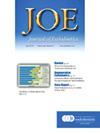Computer-assisted Dynamic Navigation for Localizing Severely Calcified Root Canals: An Analysis of Deviations, Task-focused Performance, and Operator Perception
IF 3.6
2区 医学
Q1 DENTISTRY, ORAL SURGERY & MEDICINE
引用次数: 0
Abstract
Introduction
Pulp canal obliteration (PCO) presents a significant challenge to the endodontist. This study aimed to evaluate deviations, task-focused performance, and operator perceptions during canal orifice localization using computer-assisted dynamic navigation (C-ADN) in tooth replicas with severe PCO, comparing experienced and less experienced operators.
Methods
A total of 120 tooth replicas were assigned to two operators with differing experience levels. To assess variations between planned and actual access preparations, preoperative and postoperative cone-beam computed tomography scans were superimposed using C-ADN software. Operator's task-focused performance and subjective elements resultant from operator's perspective linked to C-ADN were also evaluated. Statistical assessments were conducted using parametric methods, chi-square tests, or Fisher exact tests.
Results
Correlation analysis indicated a positive relationship among PCO depth and drilling time (r = 0.336, P < .001). Although precision measurements, including linear/angular deviations, were statistically similar among the operators (P > .05), the less experienced operator demonstrated significantly greater visuomotor coordination and drilling times, as well as higher proportions of mishaps, leading to a significantly lower task-focused performance (all P < .05). Over successive attempts, both operators showed progressive improvement in visuomotor skills and reported enhanced situational awareness, procedural quality, and safety features of C-ADN. The less experienced operator expressed concerns about workload and usability.
Conclusions
C-ADN systems are promising tools for locating calcified root canals, offering reliable guidance regardless of operators' experience. However, efficiency and mishap rates depend on experience, as mastering the visuomotor skills requires an adequate learning curve. Positive operators’ perception and usability support its integration into endodontics, provided skill development is emphasized to enhance proficiency.
计算机辅助动态导航定位严重钙化根管:偏差分析,任务聚焦性能和操作员感知。
髓管闭塞术对牙髓医生来说是一个重大的挑战。本研究旨在评估使用计算机辅助动态导航(C-ADN)对严重髓管闭塞(PCO)的牙齿副本进行根管口定位时的偏差、任务集中的表现和操作员的感知,比较经验丰富和经验不足的操作员。方法:将120个牙齿复制品分配给两名不同经验水平的操作人员。为了评估计划和实际通路准备之间的差异,使用C-ADN软件将术前和术后锥束计算机断层扫描(CBCT)进行叠加。还评估了操作员以任务为中心的表现和从操作员的角度与C-ADN相关的主观因素。采用参数方法、卡方检验或Fisher精确检验进行统计评估。结果:相关分析表明,PCO深度与钻孔时间呈正相关(r = 0.336, p0.05),经验不足的操作人员的视觉运动协调性和钻孔时间显著增加,事故发生率较高,导致任务集中性能显著降低(所有P结论:C-ADN系统是定位钙化根管的有前途的工具,无论操作人员经验如何,都能提供可靠的指导。然而,效率和故障率取决于经验,因为掌握视觉运动技能需要足够的学习曲线。积极的操作者的感知和可用性支持其集成到牙髓学,提供技能发展强调提高熟练程度。
本文章由计算机程序翻译,如有差异,请以英文原文为准。
求助全文
约1分钟内获得全文
求助全文
来源期刊

Journal of endodontics
医学-牙科与口腔外科
CiteScore
8.80
自引率
9.50%
发文量
224
审稿时长
42 days
期刊介绍:
The Journal of Endodontics, the official journal of the American Association of Endodontists, publishes scientific articles, case reports and comparison studies evaluating materials and methods of pulp conservation and endodontic treatment. Endodontists and general dentists can learn about new concepts in root canal treatment and the latest advances in techniques and instrumentation in the one journal that helps them keep pace with rapid changes in this field.
 求助内容:
求助内容: 应助结果提醒方式:
应助结果提醒方式:


